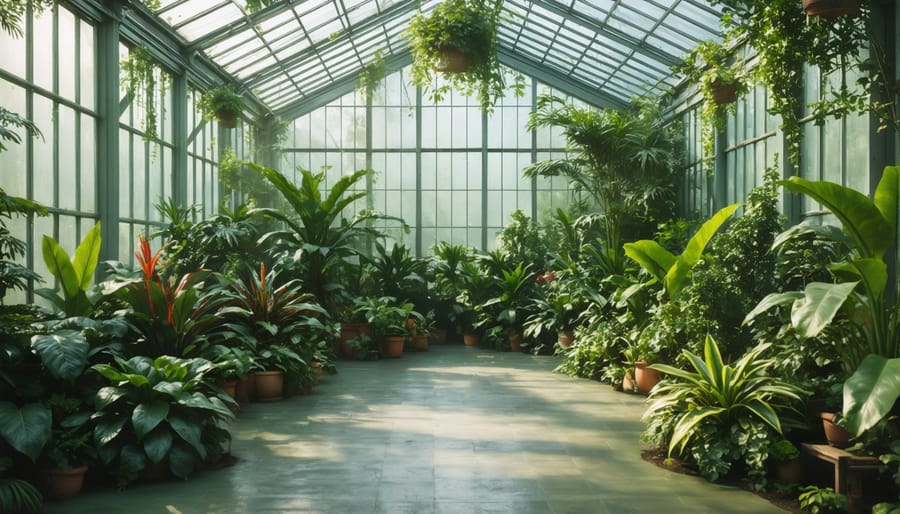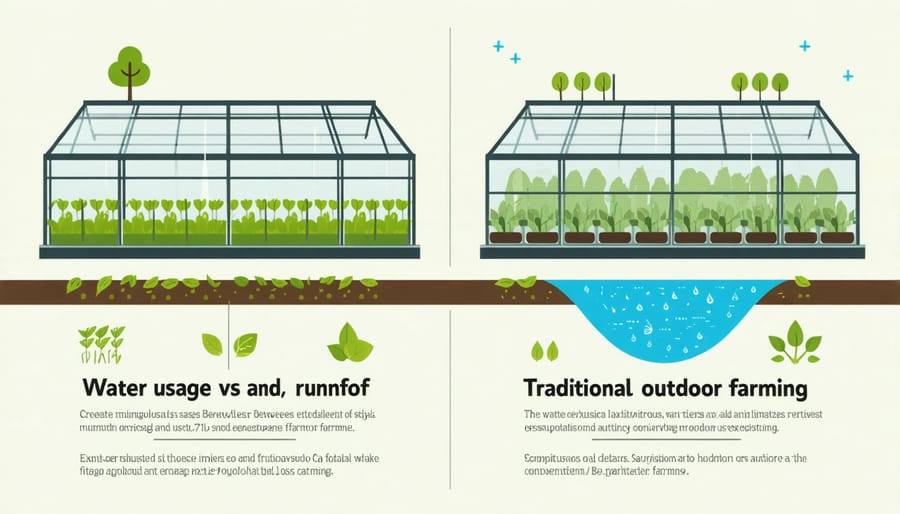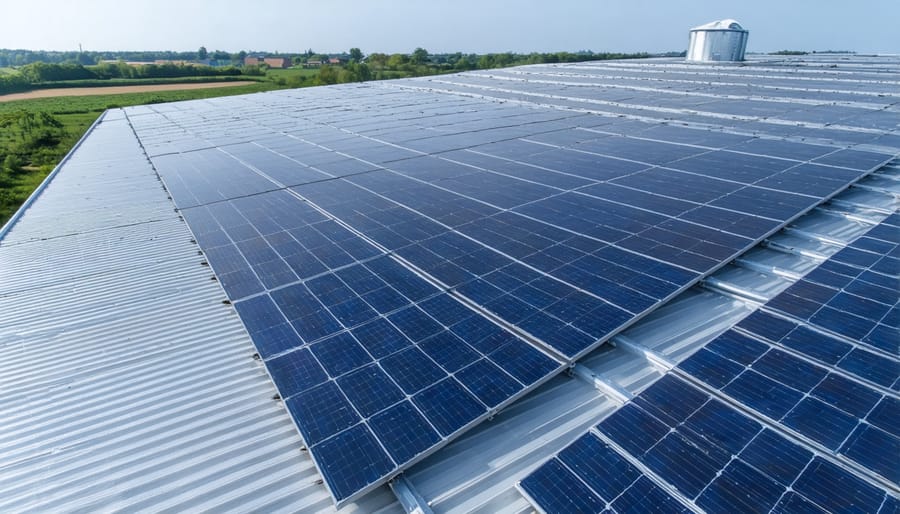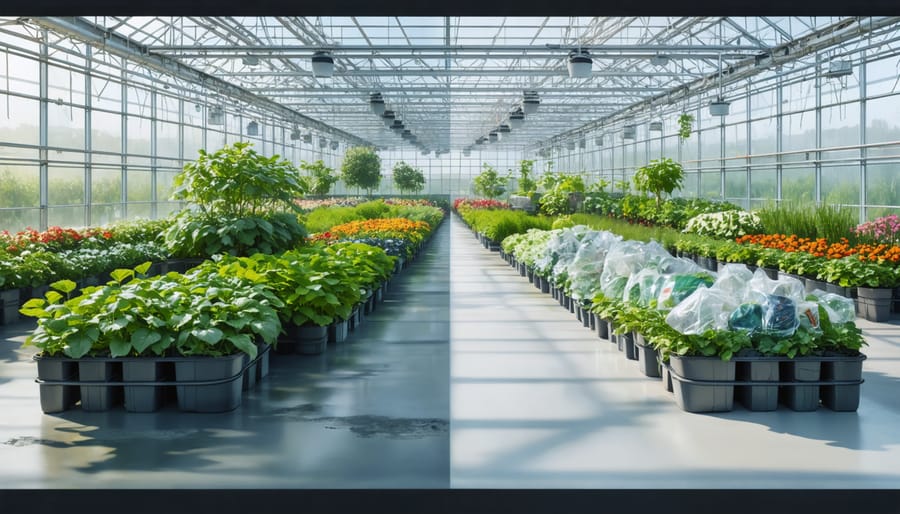Greenhouses have become a popular gardening trend, but their environmental impact is a complex issue that deserves closer examination. While these controlled growing environments offer certain benefits, such as extending the growing season and protecting crops from pests and harsh weather conditions, they also come with potential drawbacks that cannot be ignored. From energy consumption to plastic waste, greenhouses have faced valid criticisms regarding their sustainability. However, by implementing eco-friendly practices and materials, it is possible to harness the advantages of greenhouse gardening while minimizing its ecological footprint. In this article, we will explore both sides of the debate and provide practical tips for creating a greener greenhouse that promotes plant growth without compromising the health of our planet.
How Greenhouses Reduce Environmental Impact

Conserving Water and Preventing Runoff
One of the key environmental benefits of greenhouse gardening is precise control over irrigation. In an enclosed structure, growers can carefully monitor and adjust watering to meet plants’ needs without wasting this precious resource. Drip irrigation systems, which deliver targeted moisture directly to roots, are commonly used to minimize evaporation and overwatering.
This level of control also helps prevent chemical runoff, a major source of pollution in outdoor agriculture. Any excess water in greenhouses can be collected and recirculated, keeping fertilizers and pesticides contained. Some operations even utilize closed-loop hydroponic systems, where nutrient-rich water is continuously recycled with minimal discharge.
By allowing for such efficient water management, greenhouses play an important role in conservation, especially in areas prone to drought. Researchers estimate that hi-tech greenhouse irrigation can use up to 90% less water than open field cultivation of the same crops. As water scarcity becomes an increasing concern, the ability of greenhouses to grow more with less makes them an environmentally responsible option.
Of course, water usage varies depending on the specific system and climate. Greenhouse growers should still be mindful of their consumption and adopt best practices to optimize efficiency. Regular maintenance to fix leaks, use of moisture sensors, and scheduling irrigation during cooler hours can further improve water conservation in these controlled environments.

Reducing the Need for Pesticides
The controlled environment within greenhouses significantly reduces the presence of pests compared to outdoor gardens. By carefully monitoring and regulating temperature, humidity, and ventilation, greenhouse owners can create conditions that are less hospitable to common garden pests like aphids, whiteflies, and spider mites. This allows for the implementation of natural pest control methods, such as introducing beneficial insects like ladybugs and lacewings, which prey on harmful pests without the need for chemical intervention. Additionally, physical barriers like insect screens and the use of companion planting techniques can further minimize pest populations. By leveraging these natural pest management strategies, greenhouse gardeners can greatly decrease their reliance on pesticides, promoting a healthier growing environment for plants and reducing the potential for harmful chemical runoff. While some pests may still find their way into greenhouses, the ability to contain and manage them using organic methods is a significant advantage over traditional outdoor gardening. Ultimately, the reduced need for pesticides in greenhouses contributes to a more sustainable and environmentally friendly approach to growing plants, benefiting both the ecosystem and the people who enjoy the fruits of their labor.
Enabling Local Food Production
Greenhouses allow communities to grow fresh produce locally, even in regions with short growing seasons or inhospitable climates. By creating a controlled environment, greenhouses extend the growing season and enable a wider variety of crops to thrive. This localized production means fruits and vegetables travel much shorter distances to reach consumers’ plates, significantly reducing the carbon footprint associated with transportation.
Food miles, or the distance ingredients travel from farm to table, are a major contributor to the environmental impact of agriculture. Shipping produce long distances burns fossil fuels, releasing greenhouse gases. In contrast, local greenhouse-grown food minimizes these emissions. Communities with access to greenhouse produce can enjoy fresh, nutritious food year-round without the environmental toll of long-distance shipping.
Furthermore, local greenhouse agriculture supports the regional economy and fosters greater connection between growers and consumers. By purchasing from nearby greenhouses, consumers invest in their local community and have the opportunity to learn about sustainable growing practices. This awareness can encourage more environmentally-conscious choices in other areas of life. Ultimately, greenhouse technology’s ability to boost local food production is a powerful tool in creating a more sustainable and resilient food system.
The Potential Downsides of Greenhouses
Energy Consumption for Climate Control
While greenhouses offer many environmental benefits, it’s important to acknowledge the energy they consume for climate control. Heating, cooling, and lighting systems are necessary to maintain optimal growing conditions year-round, especially in colder climates or during winter months. This energy usage can contribute to greenhouse gas emissions if the power comes from fossil fuels.
However, there are ways to minimize this impact. Many modern greenhouses use energy-efficient LED lighting and automated climate control systems to reduce waste. Some even harness renewable energy sources like solar panels or geothermal heating to power their operations.
Ultimately, the energy consumption of a greenhouse depends on factors like size, location, and the crops being grown. While it’s a valid concern, it’s essential to weigh this against the numerous environmental advantages greenhouses provide, such as reducing water usage, minimizing pesticides, and extending growing seasons. With sustainable practices and innovative technologies, greenhouse growers can strike a balance between energy efficiency and the benefits of controlled environment agriculture.
Reliance on Plastics and Synthetic Materials
While greenhouses offer many environmental benefits, their reliance on plastics and synthetic materials raises some concerns. Most greenhouses use plastic coverings to allow light in while trapping heat. While effective, these plastic sheets eventually break down from UV exposure and harsh weather. Ripped and worn out plastic often ends up in landfills since it’s not readily recyclable.
The same issue applies to other plastic components like pots, trays, and irrigation systems that need periodic replacing as they crack or degrade over time. With millions of home and commercial greenhouses worldwide, this stream of hard-to-recycle plastic waste adds up.
Some greener alternatives are emerging, such as greenhouse plastics made from plant starch that can biodegrade. Using more durable materials like polycarbonate panels and repairing instead of replacing components can also reduce waste. Greenhouse owners should consider the full life cycle of materials and opt for eco-friendly options when possible. Proper maintenance and creative reuse of materials helps lessen the environmental toll. By being mindful of these issues, greenhouse enthusiasts can enjoy the benefits while minimizing the drawbacks of plastics.
Making Greenhouses More Sustainable
Choosing Efficient Designs and Materials
When it comes to greenhouse design, choosing efficient layouts and materials can greatly reduce environmental impact. Passive solar greenhouses are designed to capture and retain heat from the sun, minimizing the need for supplemental heating. This is achieved through strategic orientation, insulation, thermal mass, and natural ventilation. Cooling can also be managed passively with shade cloths, evaporative cooling, and carefully placed vents. In terms of construction, eco-friendly alternatives to traditional materials are gaining popularity. Recycled plastics, sustainably sourced wood, and energy-efficient upgrades like double-paned glass can lower a greenhouse’s carbon footprint. Green roof systems and rainwater collection further enhance sustainability. By prioritizing passive climate control techniques and environmentally conscious materials, greenhouse owners can create productive growing spaces that work with, rather than against, nature.

Harnessing Renewable Energy
Greenhouses offer exciting opportunities to harness renewable energy and reduce their environmental footprint. Installing solar panels on the greenhouse roof can generate clean electricity to power fans, heaters, and other equipment, minimizing reliance on fossil fuels. Geothermal heating systems, which tap into the earth’s stable temperature, provide an efficient and eco-friendly way to warm the greenhouse during colder months. Energy curtains, made from insulating materials, can be drawn at night to retain heat and reduce the need for supplemental heating. By implementing these sustainable technologies, greenhouse owners can significantly cut their energy consumption and carbon emissions. Additionally, using energy-efficient LED grow lights and optimizing natural ventilation through strategic window placement can further enhance the greenhouse’s energy performance. With a commitment to renewable energy solutions, greenhouses can become shining examples of sustainable agriculture, nurturing plants while protecting the planet.
In conclusion, greenhouses offer both environmental advantages and potential drawbacks depending on their design and operation. While they can extend growing seasons, reduce water usage, and protect crops, concerns exist about energy consumption, plastic waste, and chemical runoff. However, by implementing sustainable practices such as using eco-friendly materials, efficient heating and cooling systems, and organic growing methods, greenhouses can minimize their environmental impact. Incorporating renewable energy sources like solar panels can further reduce a greenhouse’s carbon footprint. With mindful implementation and a commitment to sustainability, greenhouses have the potential to be a net positive for the environment by providing locally grown produce, conserving resources, and promoting bio-diversity.





Leave a Reply